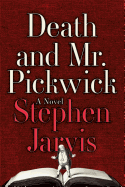

Elderly Mr Inbelicate, a large man (fat men abound in this novel) with circular spectacles, hires the young narrator, whom he takes to calling Scripty, and instructs him to use a vast accumulation of materials to produce The Pickwick Papers. Inbelicate regularly interrupts himself with asides and digressions, duly recorded by Scripty. The narrator begins his gargantuan story in 1797, and quickly populates it with familiar characters: novelist and poet Oliver Goldsmith; the "hefty" Dr. Samuel Johnson; Washington Irving; the portrait painter and friend to Keats, Joseph Severn; the caricaturist Thomas Rowlandson; book publishers Edward Chapman and William Hall; and the "large leonine head, and strong brow, and two thick groves of whiskers overhanging a laugh" of the great Dickens illustrator George Cruikshank. Nearly 500 pages in, Scripty reaches Seymour's interview with Boz, hired then to write the text to accompany the artist's new Pickwick illustrations.
Despite a winding and interwoven narrative, the tragedy of Seymour is always at the novel's core. As Scripty relates, Seymour's father was a fine furniture maker who moved to London to find success only to die soon after, leaving the family debt-ridden. Seymour's career is up and down--some success, then failure. When he finally creates a new caricature he believes holds great promise--Mr. Pickwick--his hopes are again thwarted by his publisher. He would be dead before his 40th birthday. Jarvis's detailed novel tells this sad tale with great depth and feeling.
Whether you accept his argument or not, Jarvis, via Scripty's book, provides a fascinating, detailed history of the business of publishing and book illustration in the early 19th century: how prints were made, sold, marketed and who the artists were who fulfilled the public's great thirst for them. There might be too much information for some readers, but for those who read on, it will be an education and a grand entertainment, a rich drama that unfolds at a leisurely pace, made all the more profound thanks to Jarvis's fertile imagination. --Tom Lavoie, former publisher
Shelf Talker: Welcome to an all-encompassing, multi-layered world of a famous Victorian illustrator and the "truth" behind the origins of The Pickwick Papers.

